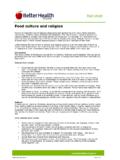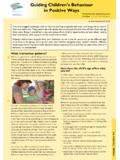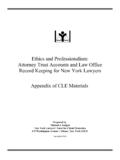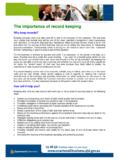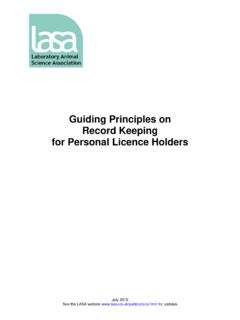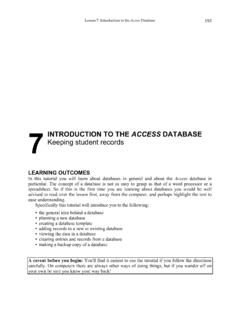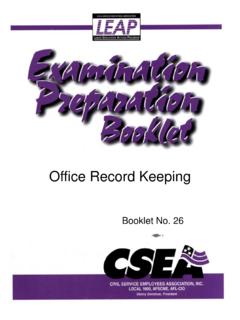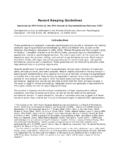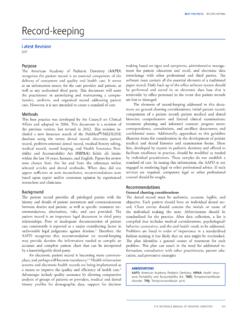Transcription of Record keeping for small business - Imagine Education
1 NAT more information visit keeping for small businessExplains what business records you need to keep and outlines a basic Record keeping for small business operatorsOUR COMMITMENT TO YOUWe are committed to providing you with accurate, consistent and clear information to help you understand your rights and entitlements and meet your you follow our information in this publication and it turns out to be incorrect, or it is misleading and you make a mistake as a result, we must still apply the law correctly.
2 If that means you owe us money, we must ask you to pay it but we will not charge you a penalty. Also, if you acted reasonably and in good faith we will not charge you you make an honest mistake in trying to follow our information in this publication and you owe us money as a result, we will not charge you a penalty. However, we will ask you to pay the money, and we may also charge you interest. If correcting the mistake means we owe you money, we will pay it to you. We will also pay you any interest you are entitled you feel that this publication does not fully cover your circumstances, or you are unsure how it applies to you, you can seek further assistance from regularly revise our publications to take account of any changes to the law, so make sure that you have the latest information.
3 If you are unsure, you can check for more recent information on our website at or contact publication was current at May 2011. AUSTRALIAN TAXATION OFFICE FOR THE COMMONWEALTH OF AUSTRALIA, 2011 You are free to copy, adapt, modify, transmit and distribute this material as you wish (but not in any way that suggests the ATO or the Commonwealth endorses you or any of your services or products).PUBLISHED BYAustralian Taxation Office Canberra May 2011 JS 19782 ABOUT THIS GUIDEIf you operate a small business or a non-profit organisation with an annual turnover of less than $2 million and you keep paper records and account on a cash basis, you can use this guide to help you.
4 N understand how money flows through your business and why you need to keep good recordsn understand the main records you may need to keepn keep basic paper recordsn complete a cash payments book and a cash receipts use the example of My business in this guide. My business is a sole trader that is registered for goods and services tax (GST) and has one casual guide may also be useful for charities, gift-deductible entities and government schools that choose to account on a cash basis. For more information, refer to Tax basics for non-profit organisations (NAT 7966).
5 TERMS WE USESome technical terms used in this guide may be new to you. They are explained in the list of definitions on page 57n When we say sales, we are referring to the GST term supplies. They include, but are not limited to, selling goods and services, leasing out or selling property, hiring out equipment, giving advice, exporting goods, and making financial When we say purchases, we are referring to the GST term acquisitions. They include, but are not limited to, purchasing goods and services, leasing or buying property, hiring equipment, and acquiring trading stock, consumables, rights, advice or information, or financial When we say GST credits, we are referring to the GST term input tax credits.
6 BOOKKEEPERSV isit , where you will find useful links to information about providing bookkeeping providing BAS-related services to clients as part of a business need to be aware of legal restrictions about who can charge a client for providing tax advice. For more information about your tax obligations as a small business operator, refer to:n Tax basics for small business (NAT 1908)n Income and deductions for small business (NAT 10710)n GST for small business (NAT 3014)n Home-based business (NAT 10709)n PAYG withholding (NAT 8075).
7 Throughout this guide you will find important notes (look for the symbol) that will help you with key information you should will also find more information boxes (look for the symbol) that will show any further steps you may need to take or supplementary information you may need to refer keeping FOR small business 101 HOW MONEY FLOWS THROUGH A business 302 keeping GOOD business RECORDS 5 Legal requirement 6 Other reasons to keep good records 6 Record keeping evaluation tool 7 Deciding whether you should keep electronic or manual records 7 Electronic Record keeping requirements 8 Lost or destroyed records 8 business records you must keep 9 Income tax records 10 GST records you must
8 Keep 13 Payments to employees 15 PAYG withholding from business payments 22 Records of fuel tax credit claims 24 Tips for healthy Record keeping 24A basic paper Record keeping system 2603 COMPLETING YOUR ACTIVITY STATEMENTS AND TAX RETURN 33 Activity statements 34 Tax returns 3404 CASH FLOW 35 Managing your cash flow 3605 SAMPLE CASH BOOKS AND ACTIVITY STATEMENT 39 Sample transactions 4106 BLANK FORMS 49 Definitions 57 Support for small business 58 Index 602 Record keeping FOR small BUSINESS01 HOW MONEY FLOWS THROUGH A BUSINESS4 Record keeping FOR small BUSINESS01 HOW MONEY FLOWS THROUGH A BUSINESSAs a business , you engage in various activities whereby money flows through your business .
9 Essentially, you have money coming into your business and money going out of your business . These money flows are called will flow into your business from four main sources, and it will flow out of your business for four main reasons each is essentially the opposite of the flowing into your business may be:n income from selling goods or services n money from selling business assetsn money you have contributed to the businessn money you have flowing out of your business may be:n payments for expenses of carrying on the businessn payments to buy or replace business assetsn payments to you from the business (drawings) n money lent to following diagram shows how money flows through a business .
10 $ inMy business $ outn Sales incomen Asset salesn Owner contributionsn Financen business expensesn Assets purchasedn Owner drawingsn Loans by the businessIn order to protect all parties, these transactions are supported by documents recording their are different types of transaction documents, including tax invoices, wages records, cheque butts and credit card statements. They contain information you need to Record , such as the: n date of the transactionn total payment or amount receivedn amount of goods and services tax (GST).
